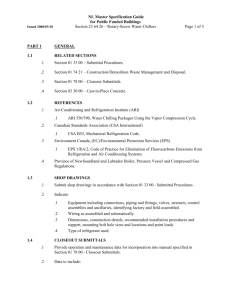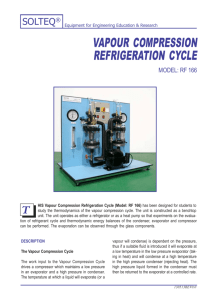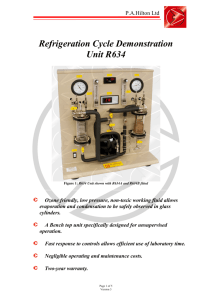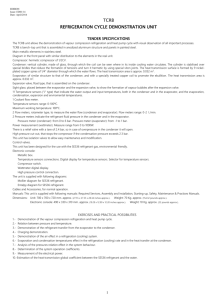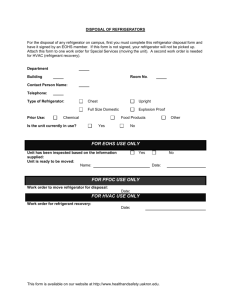Refrigerant - GTU e
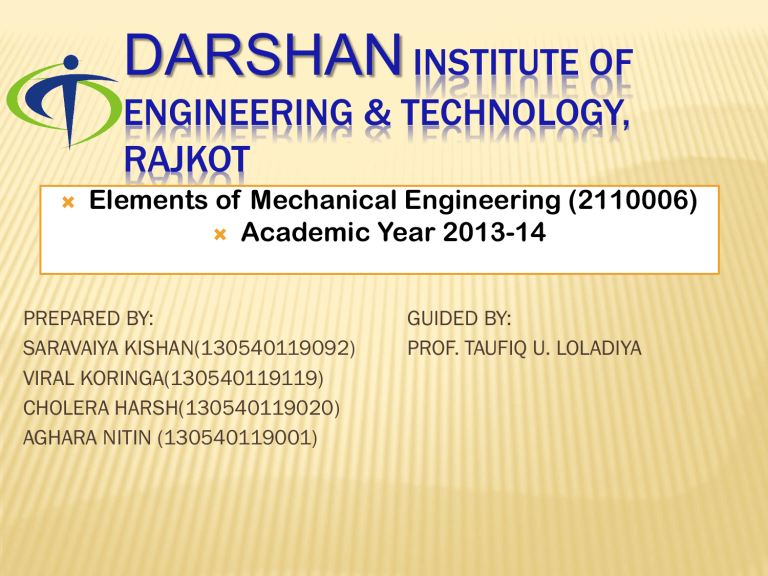
DARSHAN
INSTITUTE OF
ENGINEERING & TECHNOLOGY,
RAJKOT
Elements of Mechanical Engineering (2110006)
Academic Year 2013-14
PREPARED BY:
SARAVAIYA KISHAN(130540119092)
VIRAL KORINGA(130540119119)
CHOLERA HARSH(130540119020)
AGHARA NITIN (130540119001)
GUIDED BY:
PROF. TAUFIQ U. LOLADIYA
REFRIGERATION
&
AIR CONDITIONING
REFRIGERATION, REFRIGERATOR AND
REFRIGERANT
It can be defined as the method of reducing the temperature of a system below surrounding temperature and maintaining it at the lower temperature by continuously abstracting the heat from it.
Refrigerator is a device which removes heat from cold body and reject to hot body (surrounding) and maintains low temperature for useful purpose. In this device, external work is required to convey heat from cold body to hot body.
Refrigerant is a heat carrying medium which absorbs heat from space (desired to cool) and rejects heat to outside the refrigerator (in atmosphere).
DIFFERENCE AMONG HEAT ENGINE, HEAT PUMP
AND REFRIGERATOR
WHEN INSTALLED BACKWARD, AN AIR
CONDITIONER FUNCTIONS AS A HEAT PUMP.
APPLICATION OF REFRIGERATION
Storage and transportation of food stuffs as dairy products, fruits, vegetables, meat, fishes etc.
Preservation of medicines and syrups.
Manufacturing of ice, photographic films, rubber products.
Processing of petroleum and other chemical products.
Liquefaction of gases like N
Cooling water
2
, O
2
, H
2 etc.
Comfort air conditioning of auditoriums, hospitals, residence, offices, factories, hotels, computer rooms etc.
PROPRIETIES OF A GOOD REFRIGERANT
It should be non-toxic and non-flammable.
It should not chemically react with lubricating oil. It should be non explosive.
It should have high latent heat and positive pressure at the evaporator temperature. It should have high critical temperature and very low freezing temperature.
It should have low boiling point.
Refrigerant with odour is better as its helps in spotting any leakage.
It should not have any bad effects on the stored material when any leak develops in the system.
It must be readily available.
Good thermal conductivity for rapid heat transfer
Economical in initial cost
COMMONLY USED REFRIGERANTS
NH
3
CO
2
Air
(Ammonia)
(Carbon dioxide)
R-11 (Trichloro monofluoro methane) or Freon-ll
R-12 (Dichlaro - difluro methane) or Freon -12
R-22 (Monochloro - ditiuro methane) or Freon -
22
REFRIGERATION EFFECT
It is define as the amount of heat absorbed by refrigerant from the space to be cooled.
The capacity of refrigeration system is expressed in tons of refrigeration which is called a unit of refrigeration.
UNIT OF REFRIGERATION
Ton of Refrigeration
It is defined as "refrigerating effect produced by melting of 1 ton of ice from and at 0°C in 24 hours."
Amount of heat required to be removed in order to form one ton of ice in 24 hours from water at temperature 0 0 C.
1 ton of refrigeration=
210
KJ min
3.5
KW
CO-EFFICIENT OF PERFORMANCE (COP)
It is defined as the ratio of refrigerating effect to work required for compressing the refrigerant in the compressor. It is the reciprocal of the efficiency of a heat engine.
Thus the value of COP is always greater than unity.
Mathematically, COP=
Refrigerating effect
Work of compressor
TYPES OF REFRIGERATORS
(A) Natural refrigerator
cooling effect is produced by evaporation of liquid or sublimation of solids.
(B) Mechanical refrigerator
refrigeration effect is produced by external source of mechanical energy or heat energy.
COMMON REFRIGERATION SYSTEMS
Vapour Compression Refrigeration system
(VCR)
Vapour Absorption Refrigeration System (VAR)
Air refrigerator (Bell-Coleman cycle)
VAPOUR COMPRESSION REFRIGERATION
SYSTEM
Construction
It consists of,
(1) Evaporator
(2) compressor
(3) condenser and
(4) expansion device.
Vapour is used as refrigerant. It is circulated in system in which alternately evaporates (liquid to vapour) and condenses (vapour to liquid) thus it undergoes a change of phase. In the evaporation it absorbs the latent heat from the space to be cooled. In the condensing or cooling, it rejects heat to the atmosphere.
p-h DIAGRAM OF VAPOUR COMPRESSION
SYSTEM
FUNCTIONS OF MAIN PARTS OF VAPOUR
COMPRESSION SYSTEM
(1) Compressor
The function of the compressor is to draw the vapour through the suction line from the evaporator and compress it to high pressure and temperature.
Pressure of refrigerant coming from compressor should be such that the saturation temperature of vapour (corresponding to this pressure of vapour) is higher than the temperature of cooling medium in condenser. So that high pressure vapour can reject heat to cooling medium in the condenser.
(2) Condenser
The function of condenser is to facilitate a heat transfer surface through which heat transfer takes place from the hot refrigerant vapour to the condensing medium. In domestic refrigerator condensing medium is atmospheric air.
The condensed liquid refrigerant from the condenser is stored in a receiver from where it is supplied to the evaporator through the expansion valve or refrigerant control valve.
(3) Expansion device
The function of the expansion valve is to allow the liquid refrigerant under high pressure & temperature to pass at a controlled rate after cooling or reducing its pressure & temperature.
Some of its liquid refrigerant evaporates as it passes through the expansion valve but the greater portion is vaporized in the evaporator at the low pressure & temperature.
(4) Evaporator
An evaporator consists of coils of pipe in which the liquid vapour of refrigerant at low pressure
& temperature is evaporated & changed into the vapour refrigerant at low pressure.
In evaporator the liquid vapour refrigerant absorbs its latent heat of vaporization from the medium, which is to be cooled.
DOMESTIC VAPOUR COMPRESSION
REFRIGERATOR
Construction
It consists of an evaporator installed in the freezing compartment of the refrigerator. One end of evaporator connected to the suction side of the compressor and other end connected to condenser through throttle valve. Normally condenser installed at the backside of refrigerator.
The delivery side of compressor is connected to a condenser.
Available in capacities of 65 liters, 100 liters, 165 liters, 275Iitres, 1000 liters.
VAPOUR ABSORPTION REFRIGERATION SYSTEM
(VAR)
It consists of
(i) evaporator
(ii) condenser
(iii) generator
(iv) absorber
(v) pump and
(vi) expansion device.
In this system the refrigerant coming from evaporator is absorbed by absorber. The absorbing medium may be solid or liquid. In
VAR system, the compressor is replaced by an absorber and generator.
Ammonia is used as refrigerant
and Water is used as absorbent
WORKING
Low pressure and low temperature vapour ammonia coming from evaporator enters in the absorber where ammonia is absorbed by weak solution coming from generator through throttle valve at point 5. Due to absorption of NH
3 water, solution becomes strong. in
During absorption process heat is released and rejected to cooling water.
The strong solution from absorber is pumped into generator, where it is heated and NH
3 vapour separated from solution. In generator is supplied from external source. The weak solution at point 4 is flowing back to absorber through throttle valve. Again weak solution in absorber absorbs NH evaporator.
3 vapour coming from
NH
3 vapour coming from generator (at point 6) passes through condenser and condensed in condenser and reject heat to cooling medium.
Then liquid NH
3
(at point 7) throttled through expansion device and it enters into evaporator
(point 8). In the evaporator NH
3 evaporates by absorbing latent heat of evaporation to produce refrigerating effect. Thus the cycle is completed.
AIR REFRIGERATOR
One of the oldest types of refrigerator
air is used as refrigerant
It operates on Bell Coleman cycle.
It consists of
(1) compressor
(2) expander
(3) Cooler and
(4) Cold storage
WORKING
Process 1-2: Air from cold storage is sucked by air compressor. Air is compressed isentropically in compressor, pressure and temperature of air increases.
Process 2-3: The hot air from the compressor is cooled at constant pressure in the cooler. The temperature of air is reduced.
Process 3-4: High pressure and low temperature air is expanded isentropically in the expander.
Temperature and pressure of air decreases.
During the expansion of air work is produced.
This work is utilized to run compressor. But this work is not sufficient for compressor and so extra work to compressor.
Process 4-1: The cold air from the expander passes into the cold storage where the air sorbs heat from the bodies that is required to be cooled. Then it again enters into the compressor, cycle is completed and it is repeated again and again.
ADVANTAGES
Air is freely available from the nature.
As compared to the other refrigerator, weight of air refrigerator per ton of refrigeration capacity is low. Therefore it is used in air crafts and missiles cooling.
DISADVANTAGES
COP is very low
Requires large power
Requires more space.
The volume of air required to be circulated is more compared to refrigerant is in other refrigerator. Thus it cannot be used for large capacity plants.
COMPARISON BETWEEN VAPOUR
COMPRESSION AND VAPOUR ABSORPTION
SYSTEMS
Sr.
No
Particulars
1.
Working method
Vapour compression system (VCR)
2.
Type of the energy supplied
3.
Input work required More compression work is required
4.
5.
COP
Capacity
Mechanical work supply to compressor
High (Approx. 3)
Limited up to 1000 tons for single compressor
6.
7.
Noise
Leakage
Refrigerant vapour is compressed
More
More leakage due to high pressure
8.
Operating cost High because of compressor consumes more work
9.
Suitable refrigerant R-12
Vapour Absorption system (VAR)
Refrigerant is absorbed and heated
Heat energy supply to generator
Less mechanical energy is required to run pump
Low (Approx. 0.6)
It may be above 1000 tons
Quiet operation
Almost there is no leakage
Less because of less heat energy is required
Ammonia
AIR CONDITIONING
Objectives of Air conditioning are,
Cooling or heating of air.
Addition of moisture in air (Humidification) or removal of moisture from (dehumidification).
Purification, control movement or distribution of air and addition of fresh air from outside.
regulating the speed of air
THE BASIC COMPONENTS OF AIR-CONDITIONING
SYSTEM
Fans: For circulation of air
Filters: For cleaning air
Heating element: Heating of air (It may be electric heater, steam, hot water)
Control system: It regulates automatically the amount of cooling or heating.
Grille: It adjusts the direction of conditioned air to the room.
Tray: It collects condensed water
Refrigerating plant: Provide cooling. It consists of compressor/generator and absorber, evaporator, condenser, expansion device (capillary tube).
CLASSIFICATION OF AIR CONDITIONING SYSTEM
(A) According to arrangement of equipments
(1)Unitary system
In this system different component of air conditioning system is manufactured and assembled as unit in a factory. This unit is installed in or near to space to be conditioned.
Window air conditioner
Split air conditioner
Packaged air conditioner
(2) Central system
In this system different components are manufactured in factory and assembled at the site. This type of system is used for conditioning of air in theatres, cinemas, restaurants, exhibition halls, big factory space etc.
(B) According to the purpose
Comfort air conditioning system
Industrial air conditioning system
(C) According to season of year
Winter air conditioning system: Air is heated and humidified
Summer air conditioning system: Air is cooled and dehumidified
WINDOW AIR CONDITIONER
It is used to condition the air of a particular space such as office, room, bedroom of a house, drawing office etc. It cools the air & sometimes dehumidifies it. It operates automatically once it is put in to operation.
Window room air conditioner consists of a casing which is divided into two parts by a partition: outdoor part & indoor part.
SPLIT AIR CONDITIONER
It is the modification of window air conditioner
This unit differs from window air conditioner. In terms of split of unit into two parts. In split air conditioner, the window air conditioner divided
(split) into two parts.
First part: Includes the evaporator, filter, evaporator fan and grille (cooling coil). They placed inside the room.
Second part: Includes condenser, condenser fan, and compressor. This placed outside the
ADVANTAGES OF SPLIT AIR CONDITIONER OVER
WINDOW AIR CONDITIONER
The compressor is outside of room, therefore no compressor noise in the room.
No window opening and fixing needed.
The first part can be located in the room with decorative display. The first unit can be mounted on floor, ceiling, and wall or behind a decorative structure.
MEASURES TO BE TAKEN TO REDUCE THE
AMOUNT OF ENERGY CONSUMED BY
REFRIGERATOR
1. Open the refrigerator door the fewest times possible for the shortest duration possible.
Each time the refrigerator door is opened, the cool air inside is replaced by the warmer air outside, which needs to be cooled.
Keeping the refrigerator or freezer full will save energy by reducing the amount of cold air that can escape each time the door is opened.
2. Cool the hot foods to room temperature first before putting them into the refrigerator.
Moving a hot pan from the oven directly into the refrigerator not only wastes energy by making the refrigerator work longer, but it also causes the nearby perishable foods to spoil by creating a warm environment in its immediate surroundings
3. Clean the condenser coils located behind or beneath the refrigerator.
The dust and grime that collect on the coils act as insulation that slows down heat dissipation through them.
Cleaning the coils a couple of times a year with a damp cloth or a vacuum cleaner will improve cooling ability of the refrigerator while cutting down the power consumption by a few percent.
Sometimes a fan is used to force-cool the condensers of large or built-in refrigerators, and the strong air motion keeps the coils clean.
4. Check the door gasket for air leaks.
This can be done by placing a flashlight into the refrigerator, turning off the kitchen lights, and looking for light leaks. Heat transfer through the door gasket region accounts for almost one-third of the regular heat load of the refrigerators, and thus any defective door gaskets must be repaired immediately.
5. Avoid unnecessarily low temperature settings.
The recommended temperatures for freezers and refrigerators are 18°C and 3°C respectively. Setting the freezer temperature below 18°C adds significantly to the energy consumption but does not add much to the storage life of frozen foods.
Keeping temperatures 6°C below recommended levels can increase the energy use by as much as 25 percent.
6. Avoid excessive ice build-up on the interior surfaces of the evaporator.
The ice layer on the surface acts as insulation and slows down heat transfer from the freezer section to the refrigerant.
The refrigerator should be defrosted by manually turning off the temperature control switch when the ice thickness exceeds a few millimeters.


